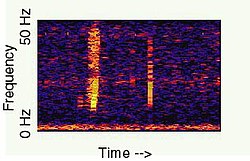Bloop
[5]: 255–256 According to the NOAA description, the sound "rose" in frequency over about one minute and was of sufficient amplitude to be heard on multiple sensors, at a range of over 5,000 km (3,000 miles).
[4] Numerous ice quakes share similar spectrograms with Bloop, as well as the amplitude necessary to detect them despite ranges exceeding 5,000 km (3,000 miles).
The iceberg(s) involved in generating the sound were most likely between Bransfield Strait and the Ross Sea; or possibly at Cape Adare, a well-known source of cryogenic signals.
[6]: 55 Icequakes, caused by the fracturing and movement of large ice masses, can produce powerful low-frequency sounds that propagate over vast distances in water.
[7] As oceanographer Yunbo Xie explains, the alteration of waveforms from a detected sound "can also be caused by so-called angular frequency dependent radiation patterns associated with antisymmetric mode motion of the ice cover.
Fox also stated that while the audio profile of Bloop does resemble that of a living creature, [2] the source was a mystery because it would be "far more powerful than the calls made by any animal on Earth.

